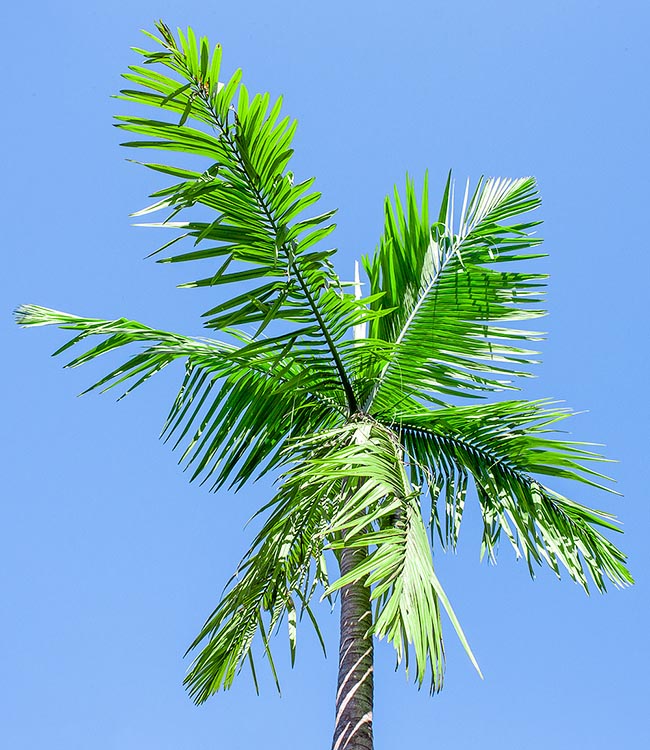Family : Arecaceae

Text © Pietro Puccio

English translation by Mario Beltramini

Native to central New Caledonia, the Kentiopsis oliviformis reaches the 30 m of height with a diameter of 25-30 cm. At extremely high risk of extinction in nature may be cultivated also in a Mediterranean climate © Giuseppe Mazza
The species is native to central New Caledonia where it lives, with a rather reduced number of specimens, in the semi-humid forest on rocky soils, from the sea level up to about 300 m of altitude.
The generic name is the combination of the name of the genus Kentia and of the Greek substantive “ὄψις” (opsis) = look, with obvious reference; that of the species is the combination of the Latin substantive “oliva, ae” = olive and of the suffix “formis” = shaped like, with reference to the fruits.
The Kentiopsis oliviformis (Brongn. & Gris) Brongn. (1873) is an unarmed monoecious species with solitary stem, up to 30 m tall and of 25-30 cm of diameter, slightly enlarged at the base, of grey colour, smooth, with annular traces at the junction of the fallen leaves.
The leaves, on a 10-15 cm long petiole, are pinnate, usually ascending, up to about 3 m long, with 40-55 pairs of lanceolate leaflets with acute to acuminate apex, 80-90 cm long and 5-6 cm broad in the median part, regularly arranged along the rachis, of intense green colour and glossy above, slightly paler below, coriaceous. The foliar base, about 1 m long, of green colour and initially covered by a thick greyish white tomentum, wraps wholly the stem.
Inflorescences, on a short peduncle, under the leaves (infrafoliar), erect, about 70 cm long, ramified at the base with several rigid rachillae, about 30 cm long, with unisexual flowers arranged in triads (one female flower between two male), the male ones about 6 mm long, with 34-37 stamens, the female about 7 mm long. The male flowers ripe before the female ones (proterandry), this favours the crossed fecundation.
Ellipsoidal fruits, 1,5-2 cm long and of 0,8-1 cm of diameter, red when ripe, containing only one ovoid seed slightly curved, about 1 cm long and 0,5 cm broad.
It reproduces by seed, previously kept in water for three days, in draining loam, maintained humid, but without stagnations, at the temperature of 26-30 °C, with variable germination times starting from one month.
The fame, not entirely deserved, of slowness, is probably the main reason for its scarce diffusion in cultivation of this elegant, decorative and versatile palm. Utilizable isolated or in group in the gardens of the tropical, subtropical and even milder temperate-warm zones, but with a lower speed of growth, where it can bear lowest temperatures around the -3 °C or little less when adult. It grows in full sun, even if in the first years it is preferable a slight shade, and on various types of soils, slightly acidic to slightly alkaline, sandy to averagely heavy, and it stands short periods of dryness, but it is preferable to irrigate it regularly in the climates with warm and dry summers, like those of the Mediterranean type, in order to speed up its growth. For this purpose are useful the fertilizations with slow-release balanced products.
Considering the restricted area of origin and the progressive deforestation due to the expansion of the pastures and of the agricultural activities, the species has been inserted into the red list of the IUCN (International Union for Conservation of Nature) among the species at extremely high risk of extinction in the forthcoming future (“Endangered”).
Synonyms: Kentia oliviformis Brongn. & Gris (1873).
→ For general notions about ARECACEAE please click here.
